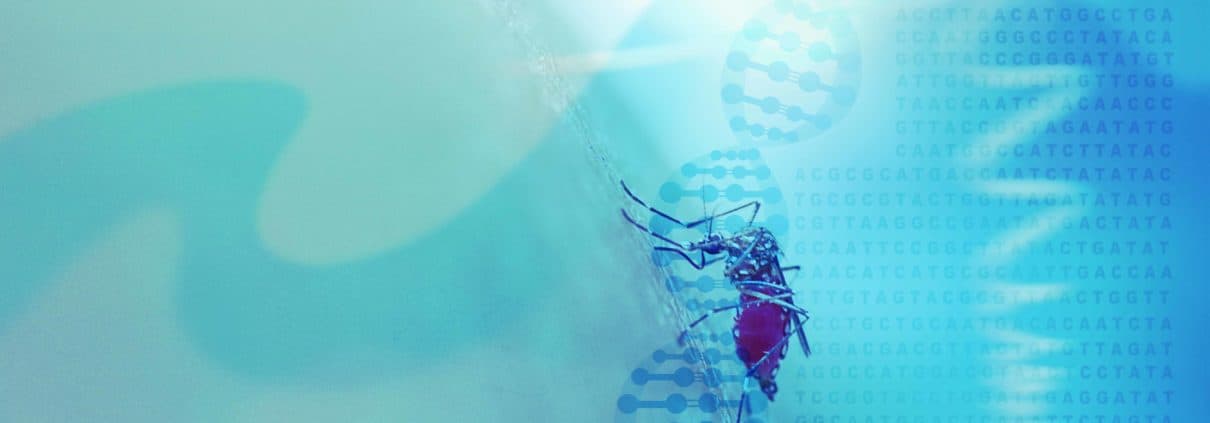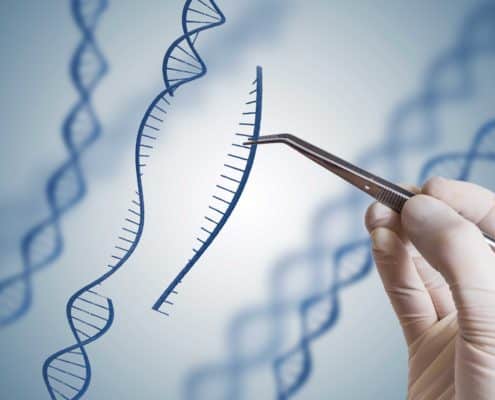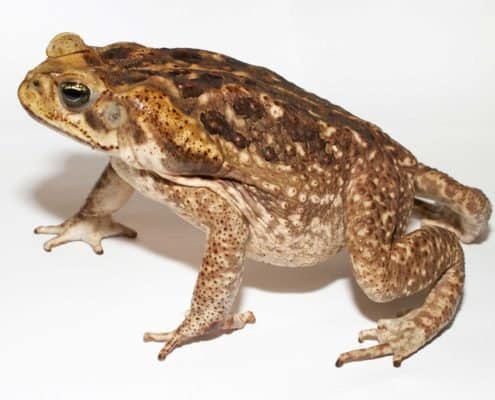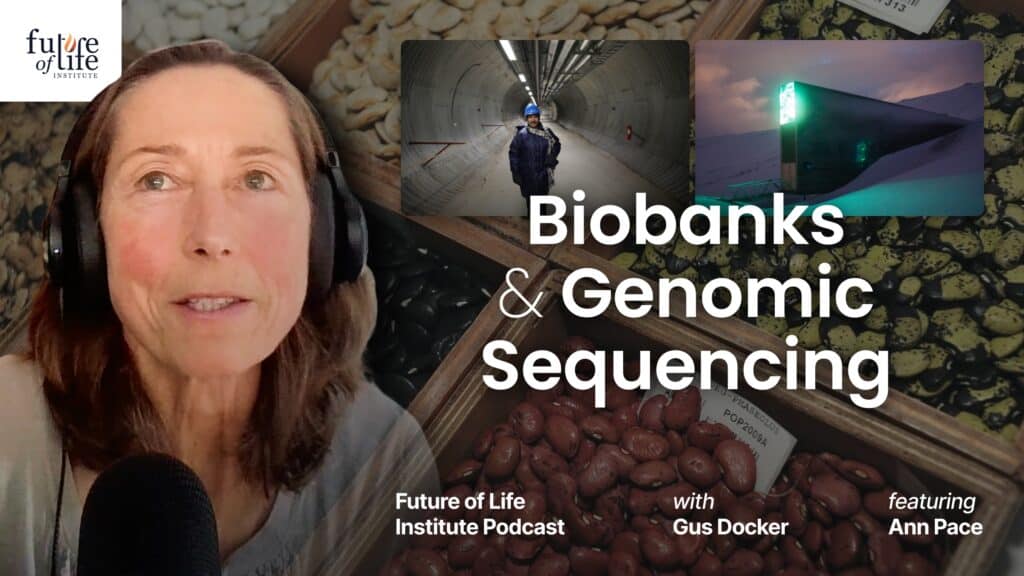Gene Drives: Assessing the Benefits & Risks

Contents
By Jolene Creighton
Most people seem to understand that malaria is a pressing problem, one that continues to menace a number of areas around the world. However, most would likely be shocked to learn the true scale of the tragedy. To illustrate this point, in 2017, more than 200 million people were diagnosed with malaria. By the year’s close, nearly half a million people had died of the disease. And these are the statistics for just one year. Over the course of the 20th century, researchers estimate that malaria claimed somewhere between 150 million and 300 million lives. With even the lowest figure, the death toll is still more than World War I, World War II, the Vietnam War, and the Korean War combined.
Although its pace has slowed in recent years, according to the World Health Organization, malaria remains one of the leading causes of death in children under five. However, there is new hope, and it comes in the form of CRISPR gene drives.
With this technology, many researchers believe humanity could finally eradicate malaria, saving millions of lives and, according to the World Health Organization, trillions of dollars in associated healthcare costs. The challenge isn’t so much a technical one. If scientists needed to deploy CRISPR gene drives in the near future, Ethan Bier, a Distinguished Professor of Cell and Developmental Biology at UC San Diego, notes that they could reliably do so.
However, there’s a hitch. In order to eradicate malaria, we would need to use anti-malaria gene drives to target three specific species (maybe more) and force them into extinction. This would be one of the most audacious attempts by humans to engineer the planet’s ecosystem, a realm where humans already have a checkered past. Such a use sounds highly controversial, and of course, it is.
However, regardless of whether the technology is being deployed to try and save a species or to try and force it into extinction, a number of scientists are wary. Gene drives will permanently alter an entire population. In many cases, there is no going back. If scientists fail to anticipate properly all of the effects and consequences, the impact on a particular ecological habitat — and the world at large — could be dramatic.
Rewriting Organisms: Understanding CRISPR

CRISPR/Cas9 editing technology enables scientists to alter DNA with enormous precision.
This degree of genetic targeting is only possible because of the unification of two distinct gene editing technologies: CRISPR/Cas9 and gene drives. On their own, each of these tools is powerful enough to alter a gene pool dramatically. Together, they can erase that pool entirely.
The first part of this equation is CRISPR/Cas9. More commonly known as “CRISPR,” this technology is most easily understood as a pair of molecular scissors. CRISPR, which stands for “Clustered Regularly Interspaced Palindromic Repeats,” was adapted from a naturally occurring defense system that’s found in bacteria.
When a virus invades a host bacteria and is defeated, bacteria are able to capture the virus’ genetic material and merge snippets of it into their genomes. The virus’ genetic material is then used to make guide RNA. These guide RNA target and bind to complementary genetic sequences. When a new virus invades, the guide RNA will find the complementary sequences on the attacking virus and attach itself to that matching portion of the genome. From there, an enzyme known as Cas9 cuts it apart, and the virus is destroyed.
Lab-made CRISPR allows humans to accomplish much the same — cut any region of the genome with relatively high precision and accuracy, often disabling any cut sequence in the process. However, scientists have the ability to go a step farther than nature. After a cut is made using CRISPR, scientists can use the cell’s own repair machinery to add or replace an existing segment of DNA with a customized DNA sequence i.e. a customized gene.
If genetic changes are made in somatic cells (the non-reproductive cells of a living organism) — a process known as “somatic gene editing” — it only affects the organism in which the genetic changes were made. However, if the genetic changes are made in the germline (the sequence of cells that develop into eggs and sperm) — a process known as “germline editing” — then the edited gene can spread to the organism’s offspring. This means that the synthetic changes — for good or bad — could permanently enter the gene pool.
But by coupling CRISPR with gene drives, scientists can do more than spread a gene to the next generation — they can force it through an entire species.
Rewriting Species: Understanding Gene Drives
Most species on our planet have two copies of their genes. During the reproductive cycle, one of these genes is selected to be passed on to the next generation. Because this selection process occurs randomly in nature, there’s about a 50/50 chance that any given gene will be passed down.
Gene drives change those odds by increasing the probability that a specific gene (or suite of genes) will be inherited. Surprisingly, scientists have known about gene drive systems since the late 1800s. They occur naturally in the wild thanks to something known as “selfish genetic elements” (“selfish genes).” Unlike most genes, which wait patiently for nature to randomly select them for propagation, selfish genes use a variety of mechanisms to manipulate the reproductive process and ensure that they get passed down to more than 50% of offspring.
One way that this can be achieved is through segregation distorters, which alter the replication process so that a gene sequence is replicated more frequently than others. Transposable elements, on the other hand, allow genes to move to additional locations in the genome. In both instances, the selfish genes use different mechanisms to increase their presence on the genome and, in so doing, improve their odds of being passed down.
In the 1960s, scientists first realized that humanity might be able to use a gene drive to dictate the genetic future of a species. Specifically, biologists George Craig, William Hickey, and Robert Vandehey argued that a mass release of male mosquitoes with a gene drive that increased the number of male offspring could reduce the number of females, the sex that transmits malaria, “below the level required for efficient disease transmission.” In other words, the team argued that malaria could be eradicated by using a male-favoring gene drive to push female mosquitoes out of the population.
However, gene editing technologies hadn’t yet been invented. Consequently, gathering a mass of mosquitoes with this specific gene drive was impossible, as scientists were forced to rely on time-consuming and imprecise breeding techniques.
Then, in the 1970s, Paul Berg and his colleagues created the first molecule made of DNA from two different species, and laboratory-based genetic engineering was born. And not too long after that, in 1992, Margaret Kidwell and José Ribeiro proposed attaching a specific gene to selfish genes to drive the gene through a mosquito population and make it malaria-resistant.
But despite the theoretical ingenuity of these designs, when it came to deploying them in reality, progress was elusive. Gene editing tools were still quite crude. As a result, they caused a number of off-target edits, where portions of the genome were cut unintentionally and segments of DNA were added in the wrong place. Then CRISPR came along in 2012 and changed everything, making gene editing comparably fast, reliable, and precise.
It didn’t take scientists long to realize that this new technology could be used to create a remarkably powerful, remarkably precise human-made selfish gene. In 2014, Kevin M Esvelt, Andrea L Smidler, Flaminia Catteruccia, and George M. Church published their landmark paper outlining this process. In their work, they noted that by coupling gene drive systems with CRISPR, researchers could target specific segments of a genome, insert a gene of their choice, and ultimately ensure that the gene would make its way into almost 100% of the offspring.
Thus, CRISPR gene drives were born, and it is at this juncture that humanity may have acquired the ability to rewrite — and even erase — entire species.
The Making of a Malaria-Free World

To eradicate malaria, at least three species of mosquitos would have to be forced into extinction.
Things move fast in the world of genetic engineering. Esvelt and his team only outlined the process through which scientists could create CRISPR gene drives in 2014, and researchers have had working prototypes for nearly as long.
In December of 2015, scientists published a paper announcing the creation of a CRISPR gene drive that made Anopheles stephensi, one of the primary mosquito species responsible for the spread of malaria, resistant to the disease. Notably, the gene drive was just as effective as earlier pioneers had predicted: Although the team initially started with just two genetically edited males, after only two generations of cross-breeding, they had over 3,800 third generation mosquitoes, 99.5% of which expressed genes indicating that they had acquired the genes for malaria resistance.
However, in wild populations, it’s likely that the malaria parasite would eventually develop resistance to the gene drive. Thus, other teams have focused their efforts not on malaria resistance, but making mosquitoes extinct. As a side note, it must be stressed that no one was (or is) suggesting that we should exterminate all mosquitoes to end malaria. While there are over 3000 mosquito species, only 30 to 40 mosquito species transmit the disease, and scientists think that we could eradicate malaria by targeting just three of them.
In September of 2018, humanity took a major step towards realizing this vision, when scientists at the Imperial College London published a paper announcing that one of their CRISPR gene drives had wiped out an entire population of lab-bred mosquitoes in less than 11 generations. If this approach were released into the wild, the team predicted that it could propel the affected species into extinction in just one year.
For their work, the team focused on Anopheles gambiae and targeted genes that code proteins that play an important role in determining an organism’s sexual characteristics. By altering the gene, the team was able to create female mosquitoes that were infertile. What’s more, the drive seems to be resistance-proof.
There is still some technical work to be done before this particular CRISPR gene drive can be deployed in the wild. For starters, the team needs to verify that it is, in fact, resistant-proof. The results also have to be replicated in the same conditions in which Anopheles mosquitoes are typically found — conditions that mimic tropical locations across sub-Saharan Africa. Yet the researchers are making rapid progress, and a CRISPR gene drive that can end malaria may soon be a reality.
Moving Beyond Malaria
Aside from eradicating malaria, one of the most promising applications of CRISPR gene drives involves combating invasive species.
For example, in Australia, the cane toad has been causing an ecological crisis since the 1930s. Originating in the Americas, the cane toad was introduced to Australia in 1935 by the Bureau of Sugar Experiment Stations in an attempt to control beetle populations that were attacking sugar cane crops. However, the cane toad has no natural predators in the area, and so has multiplied at an alarming rate.

Since its 1935 introduction to Australia, the poisonous cane toad has decimated populations of native species that attempt to prey on it. A gene drive could be used to eliminate its toxicity.
Although only 3,000 were initially released, scientists estimate that the cane toad population in Australia is currently over 200 million. For decades, the toads have been killing a number of native birds, snakes, and frogs that prey on it and inadvertently ingest its lethal toxin — the population of one monitor lizard species dropped by 90% after the cane toad spread to its area.
However, by genetically modifying the cane toads to keep them from producing these toxins, scientists believe they might be able to give native species a fighting chance. And because the CRISPR gene drive would only target the cane toad population, it may actually be safer than traditional pest control methods that involve poisons, as these chemicals impact a multitude of species.
Research indicates that CRISPR gene drives could also be used to target a host of other invasive pests. In January of 2019, scientists published a paper demonstrating the first concrete proof that the technology also works in mammals — specifically, lab mice.
Another use case involves deploying CRISPR gene drives to alter threatened or endangered organisms in order to better equip them for survival. For instance, a number of amphibian species are in decline because of the chytrid fungus, which causes a skin disease that is often lethal. Esvelt and his team note that CRISPR gene drives could be used to make organisms resistant to this fungal infection. Currently, there is no resistance mechanism for the fungus, so this specific use case is just a theoretical application. However, if developed, it could be deployed to save many species from extinction.
The Harvard Wyss Institute suggests that CRISPR gene drives could also be used “to pave the way toward sustainable agriculture.” Specifically, the technology could be used to reverse pesticide resistance in insects that attack crops, or it could be used to reverse herbicide resistance in weeds.
Yet, CRISPR gene drives are powerless when it comes to some of humanity’s greatest adversaries.
Because they are spread through sexual reproduction, gene drives can’t be used to alter species that reproduce asexually, meaning they can’t be used in bacteria and viruses. Gene drives also don’t have a practical applications in humans or other organisms with long generational periods, as it would take several centuries for any impact to be noticeable.. The Harvard Wyss institute notes that, at these timescales, someone could easily create a reversal drive to remove the trait, and any number of other unanticipated events could prevent the drive from propagating.
That’s not to say that reverse gene drives should be considered a safety net in case forward gene drives are weaponized or found to be dangerous. Rather, the primary point is to highlight the difficulty in using CRISPR gene drives to spread a gene throughout species with long generational and gestational periods.
But, as noted above, when it comes to species that have short reproductive cycles, the impact could be profound on extremely short order. With this in mind — although the work in amphibian, mammal, and plant populations is promising — the general scientific consensus is that the best applications for CRISPR gene drives likely involve insects.
Entering the Unknown
Before scientists introduce or remove a species from a habitat, they conduct research in order to understand the role that it plays within the ecosystem. This helps them better determine what the overall outcome will be, and how other individual organisms will be impacted.
According to Matan Shelomi, an entomologist who specializes in insect microbiology, scientists haven’t found any organisms that will suffer if three mosquitoes species are driven into extinction. Shelomi notes that, although several varieties of fish, amphibians, and insects eat mosquito larvae, they don’t rely on the larvae to survive; in fact, most of the organisms that have been studied prefer other food sources, and no known species live on mosquitoes alone. The same, he argues, can be said of adult mosquitoes. While a number of birds do consume mature mosquitoes, none rely on them as a primary food source.
Shelomi also notes that mosquitoes don’t play a critical role in pollination — or any other facet of the environment that scientists have examined. As a result, he says they are not a keystone species: “No ecosystem depends on any mosquito to the point that it would collapse if they were to disappear.”
At least, not as far as we are aware.
Because CRISPR gene drives cause permanent changes to a species, virologist Jonathan Latham notes that it is critical to get things right the first time: “They are ‘products’ that will likely not be able to be recalled, so any approval decision point must be presumed to be final and irreversible.” However, we have no way of knowing if scientists have properly anticipated every eventuality. “We certainly do not know all the myriad ways all mosquitoes interact with all life forms in their environment, and there may be something we are overlooking,” Shelomi admits. Due to these unknown unknowns, and the near irreversibility of CRISPR gene drives, Latham argues that they should never be deployed.
Every intervention has consequences. To this end, the important thing is to be as sure as possible that the potential rewards outweigh the risks. For now, when it comes to anti-malaria CRISPR gene drives, this critical question remains unanswered. Yet the applications for CRISPR gene drives extend far beyond mosquitoes, making it all the more important for scientists to ensure that their research is robust and doesn’t cause harm to humanity or to Earth’s ecosystems.
Risky Business, Designed for Safety
Although some development is still needed before scientists would be ready to release a CRISPR gene drive into a wild insect population, the most pressing issues that remain are of a regulatory and ethical nature. These include:
Limiting Deployment and Obtaining Consent
For starters, who gets to decide whether or not scientists should eradicate a species? The answer most commonly given by scientists and politicians is that the individuals who will be impacted should cast the final vote. However, substantial problems arise when it comes to limiting deployment and determining the degree to which informed consent is necessary.
Todd Kuiken, a Senior Research Scholar with the Genetic Engineering and Society Center at NC State University and a member of the U.N.’s technical expert group for the Convention on Biological Diversity, notes that, “in the past, these kinds of applications or introductions were mostly controlled in terms of where they were supposed to go.” Gene drives are different, he argues, because they are “designed to move, and that’s really a new concept in terms of environmental policy. That’s what makes them really interesting from a policy perspective.”

The highly globalized nature of the modern world would make it near-impossible to geographically contain the effects of a gene drive.
For example, if scientists release mosquitoes in a town in India that has approved the work, there is no practical way to contain the release to this single location. The mosquitoes will travel to other towns, other countries, and potentially even other continents.
The problem isn’t much easier to address even if the release is planned on a remote island. The nature of modern life, which sees people and goods continually traveling across the globe, makes it extremely difficult to prevent cross contamination. A CRISPR gene drive deployed against an invasive species on an island could still decimate populations in other places — even places where it is native and beneficial.
The release of a single engineered gene drive could, potentially, impact every human on Earth. Thus, in order to obtain the informed consent from all affected parties, scientists would effectively need to ensure that they had permission from everyone on the planet.
To help address these issues of “free, prior, and informed consent,” Kuiken notes that scientists and policymakers must establish a consensus on the following:
- What communities, organizations, and groups should be part of the decision-making process?
- How far out do you go to obtain informed consent — how many centric circles past the introduction point do you need to move?
- At which decision stage of the project should these different groups or potentially impacted communities be involved?
Of course, in order for individuals to effectively participate in discussions about CRISPR gene drive, they will have to know what it is. This also poses a problem: “Generally speaking, the majority of the public probably hasn’t even heard of it,” Kuiken says.
There are also questions about how to verify that an individual is actually informed enough to give consent. “What does it really mean to get approval?” Kuiken asks, noting, “the real question we need to start asking ourselves is ‘what do we mean by [informed consent]?’”
Because research into this area is already so advanced, Kuiken notes that there’s an immediate need for a broad range of endeavors aimed at improving individuals’ knowledge of, and interest in, CRISPR gene drives.
Expert Inclusion
And it’s not just the public that need schooling. When it comes to scientists’ understanding of the technology, there are also serious and significant gaps. The degree and depth of these gaps, Kuiken is quick to point out, varies dramatically from field to field. While most geneticists are at least vaguely familiar with CRISPR gene drives,some key disciplines are still in the dark: one of the key findings of this year’s upcoming IUCN (International Union for Conservation of Nature) report is that “the conservation science community is not well aware of gene drives at all.”
“What concerns me is that a lot of the gene drive developers are not ecologists. My understanding is that they have very little training, or even zero training, when it comes to environmental interactions, environmental science, and ecology,” Kuiken says. “So, you have people developing systems that are being deliberately designed to be introduced to an environment or an ecosystem who don’t have the background to understand what all those ecological interactions might be.”
To this end, scientists working on gene drive technologies must be brought into conversations with ecologists.
Assessing the Impact
But even if scientists work together under the best conditions, the teams will still face monumental difficulties when trying to assess the impact and significance of a particular gene drive.
To begin with, there are issues with funding allocation. “The research dollars are not balanced correctly in terms of the development of the gene drive verses what the environmental implications will be,” Kuikon says. While he notes that this is typically how research funds are structured — environmental concerns come in last, if they come at all — CRISPR gene drives are fundamentally about the environment and ecology. As such, the funding issues in this specific use case are troubling.
Yet, if proper funding were secured, it would still be difficult to guarantee that a drive was safe. Even a small gap in our

Alterations made to a single species can have a detrimental impact on an entire ecosystem.
understanding of a habitat could result in a drive being released into a species that has a critical ecological function in its local environment. As with the cane toad in Australia, this type of release could cause an environmental catastrophe and irreversibly damage an ecosystem.
One way to help prevent adverse ecological impacts is to gauge the effect through daisy-chain gene drives. These are self-limiting drives that grow weaker and weaker and die off after a few generations, allowing researchers to effectively measure the overall impact while restricting the gene drive’s spread. If such tests determine that there are no unfavorable effects, a more lasting drive can subsequently be released.
Kill-switches offer another potential solution. The Defense Advanced Research Projects Agency (DARPA) recently announced that it was allocating money to fund research into anti-CRISPR proteins. These could be used to prevent the expression of certain genes and thus counter the impact of a gene drive that has gone rogue or was released maliciously.
Similarly, scientists from North Carolina State University’s Genetic Engineering and Society Center note that it may be beneficial to establish a regulatory framework requiring the development of immunizing drives, which spread resistance to a specific gene drive, to be developed alongside drives that are intended for release. These could be used to immunize related species that aren’t being targeted, or kept on the ready in case of any unanticipated occurrences.
An Uncertain Future
But even if scientists do everything right, and even if researchers are able to verify that CRISPR gene drives are 100% safe, it doesn’t mean they will be deployed. “You can move yourself far in terms of generally scientific literacy around gene drives, but people’s acceptance changes when it potentially has a direct impact on them,” Kuiken explains.
To support his claims, Kuiken points to the Oxitec mosquitoes in Florida.
Here, teams were hoping to release male Aedes aegypti mosquitoes carrying a “self-limiting” gene. These are akin to, but distinct from, gene drives. When these edited males mate with wild females, the offspring inherit a copy of a gene that prevents them from surviving to adulthood. Since they don’t survive, they can’t reproduce, and there is a reduction in the wild population.
After working with local communities, Oxitec put the release up for a vote. “The vote count showed that, generally speaking, it you tallied up the whole area of South Florida, it was about a 60 to 70 percent approval. People said, ‘yeah, this is a really good idea. We should do this,’” Kuiken said. “But when you focused in on the areas where they were actually going to release the mosquitoes, it was basically flipped. It was a classic ‘not in my backyard’ scenario.”
That fear, especially when it comes to CRISPR gene drives, isn’t really too hard to comprehend. Even if every scientific analysis showed that the benefits of these drives outweighed all the various drawbacks, there would still be the unknown unknowns.
Researchers can’t possibly account for how every single species — all the countless plants, insects, and as yet undiscovered deep sea creatures — will be impacted by a change we make to an organism. So unless we develop unique and unprecedented scientific protocols, no matter how much research we do, the decision to use or not use CRISPR gene drives will have to be made without all the evidence.
About the Future of Life Institute
The Future of Life Institute (FLI) is a global think tank with a team of 20+ full-time staff operating across the US and Europe. FLI has been working to steer the development of transformative technologies towards benefitting life and away from extreme large-scale risks since its founding in 2014. Find out more about our mission or explore our work.
Related content
Other posts about Biotech, Recent News

The U.S. Public Wants Regulation (or Prohibition) of Expert‑Level and Superhuman AI

Poll Shows Broad Popularity of CA SB1047 to Regulate AI


